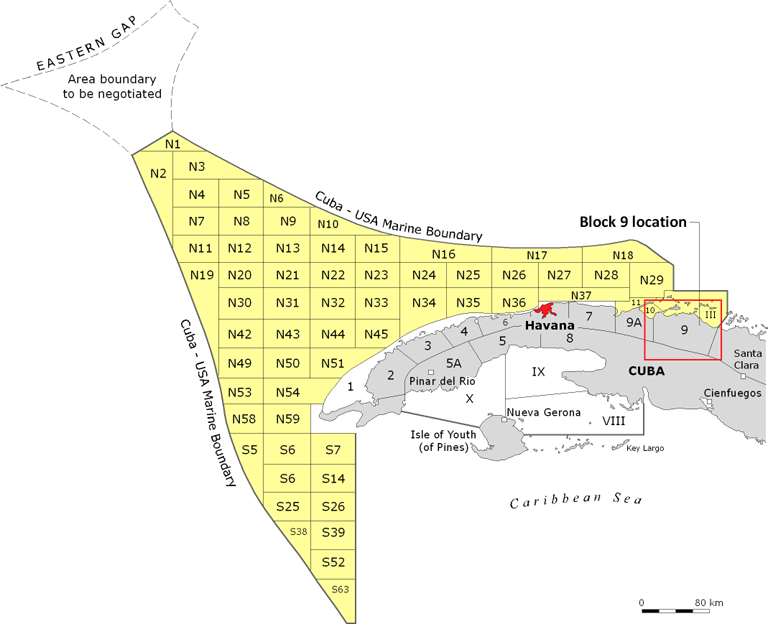Melbana Energy provides an operational update regarding Block 9 PSC onshore Cuba, for which it is operator and holds a 30% interest.
Highlights
- Flow-testing indicates a highly permeable reservoir, but no oil was recovered.
- Well drilled to a total depth of 2,000 metres measured depth.
- A total of 169 metres measured depth of highly porous net reservoir intersected.
- Plug and abandonment of Amistad-2 now proceeding.
- Acquisition of a low-cost 2D seismic survey nearing completion.
Melbana Energy’s Executive Chairman, Andrew Purcell, commented:
“The testing of Amistad-2 is disappointing given the well was updip of known oil, but this can occur in the early-stage appraisal and development of new oilfields. Oil shows were muted during the drilling, perhaps because the reservoir drilling fluid we have designed for these formations was in balance and doing its job, but well logs indicated good reservoir quality and reasonable oil saturation. Flow testing confirmed excellent reservoir quality, given the high rate of fluid recovery, but oil was residual at that location. The rate of drilling was also quicker than prognosed, allowing us to continue drilling the encountered formation much deeper than originally planned.
The result of Amistad-2 has placed renewed importance on the low-cost 2D seismic survey currently underway to assist with future well positioning and trajectories. We will use these data with our analysis of the information gained from Amistad-2 to inform our forward work program in Block 9, which we look forward to announcing directly.”

Amistad-2 Production Well
Amistad-2 was spudded on 18 September 2025 and was originally planned to take about three weeks to drill to a total depth (TD) of 1125 metres measured depth (m.MD). Drilling results confirmed the pre-drill structural shape but also showed the primary target in the “hanging wall” of the structure had been eroded and replaced with sediment and that this had happened prior to the most recent phase of structuring.
The top of limestone was therefore encountered in the low-side (foot-wall) of the structure, approximately 600 m.MD deep to prognosis, so the decision was made to continue drilling past the original TD, given the good drilling conditions, before deciding to stop (whilst still in the reservoir formation) at 2000 m.MD at a cost of only about one extra week’s drilling time.
The well was drilled at a lower mud weight than Amistad-1 and the custom reservoir drilling fluid, designed using the learnings of the previous wells drilled in Block 9, was very good and allowed the removal of barite from the drilling fluid in the lower portion of the well. The lower mud weight also assisted with the well drilling at a higher rate of penetration than expected.
An extensive logging program was conducted and provided positive indications of extensive porosity and oil saturation within the 8-1/2” hole. Subsequent preliminary petrophysical analysis interpreted a total 169 m.MD, or 146 metres of true vertical depth (TVD), net reservoir based on a conventional cut-off of 9% porosity.
The reservoir in Amistad-2 is comprised of three primary sections: the upper-most section is highly porous and correlated to the Unit 1A observed in Alameda-2; the second unit is separated from shallower Unit 1A by a tight limestone interval and appears to be consistent with the Unit 1B Lower interval previously observed by Alameda-2; and, the third appears to be a repeat section of Unit 1B, but in a rotated and steeply dipping position. Ongoing analysis aims to confirm the stratigraphic sequence encountered by Alameda-2.
An acid-soak was spotted across the entire reservoir interval before being circulated out without incident. Tubing and a pump were then run in hole and Amistad-2 was opened for testing on 31 October 2025 (Cuba time). Initial flow confirmed a highly permeable reservoir averaging 550 bbl/d minimal pressure drawdown in the first 24 hours. The pump rate continued to be increased, with a final average rate of 1220 bbl/d of water with minimal pressure drawdown. Cumulative water produced during testing was approximately 1840 bbl, around twice the total combined wellbore and volume of drilling, acid and completion brine/water lost during operations.
Pressure data from the well indicates that the reservoirs at the Amistad-2 location are not in communication with those at the Alameda-2 location.
In recent weeks, Melbana has been acquiring 2D seismic data using a highly mobile hydraulic weight-drop system and associated geophone receivers. The Company commenced the acquisition of these data, primarily along existing roads and proposed well locations, to aid in the identification of potential shallow drilling hazards. Preliminary processing of the first line indicates good data quality and the potential for the acquired data to supplement, and potentially replace, the vintage seismic data which has been utilised to date for well targeting.
Given the results of Amistad-2 consideration is now being given to Amistad-11 replacing Amistad-3 as the next well. This would be a shallow production well located on Pad 1, where good production characteristics have previously been obtained (peak flow of 1,903 BOPD at a sustained rate of 1,235 BOPD). Production operations in Amistad-1 have been temporarily halted to prepare for the drilling of this well in case the Joint Operation approves this course of action.

Amistad-2 well trajectory oriented to intercept fractures and penetrate all of Unit 1B
KeyFacts Energy: Melbana Energy Cuba country profile
 KEYFACT Energy
KEYFACT Energy